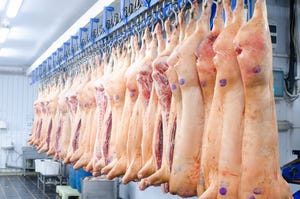RAPP targets key regions for U.S. pork
Diversification high priority as industry seeks to expand the global footprint of U.S. red meat.
January 10, 2024

U.S. Agriculture Secretary Tom Vilsack recently announced plans to utilize Commodity Credit Corporation funding to bolster support for agricultural exports. Over the next five years, USDA’s new Regional Agricultural Promotion Program is set to provide $1.2 billion to support eligible projects aimed at expanding exports into new markets and increasing market share in growth markets. The first tranche of RAPP funding, which is expected to be activated in June 2024, will provide up to $300 million.
Because diversification is a key goal of RAPP, some large export markets will be ineligible for the first tranche of funding: China (including Hong Kong and Macau), Canada, Mexico and the European Union. All other markets are eligible, except for those in which sanctions or other legal barriers are in place.
Three regions have been identified for special emphasis in the first tranche of RAPP funding: Latin America/Caribbean, South/Southeast Asia and Africa. In fact, USDA has specifically set aside $25 million from the first tranche to fund activities in Africa.
According to U.S. Meat Export Federation President and CEO Dan Halstrom, diversification has always been a high priority for USMEF and its members, as the red meat industry seeks to expand the global footprint of U.S. red meat.
“USMEF often gets questions about emerging markets and the regions that hold promise for future growth, because producers and other stakeholders understand the importance of reaching a broad range of export destinations,” Halstrom explained. “Developing these markets requires time, patience and resources, so we are excited to see USDA make such a strong commitment to market diversification. For U.S. pork, this is especially critical for enhancing the value of every cut and variety meat item and, in turn, maximizing the return on every head slaughtered.”
Favorable access, education drives growth in Latin America
Among the regions identified as priorities for RAPP funding, Latin America/Caribbean is the most advanced in terms of current demand for U.S. pork. This is due in part to the favorable access achieved through regional and bilateral trade agreements, but also to the commitments made by pork producers and other industry partners, as well as USDA, to funding activities that capitalize on these agreements.
“As our trade agreements in Central America and the Dominican Republic were entering into force, we could see momentum building for U.S. pork,” Halstrom said. “Then came the agreement with Colombia, which brought access to a very large population and – in combination with the existing agreements with Chile and Peru – made South America an extremely promising region as well.”
These developments helped give rise to USMEF’s Latin American Product Showcase – an activity first held in Panama in 2011 that has grown into the go-to event for U.S. exporters and prospective meat buyers from throughout Central and South America and the Caribbean. Early growth for U.S. pork was mainly in the category of raw material for further processing, and this still accounts for a large portion of U.S. pork exports to Latin America. But USMEF prioritized culinary seminars, buyer training sessions and other educational activities that greatly expanded U.S. pork’s presence in the retail and foodservice sectors.
While 2023 was a record-shattering year for U.S. pork exports to Mexico, other Western Hemisphere destinations shined as well. Through November, exports to Central America increased 15% year-over-year to 119,348 metric tons, while value climbed 20% to $352.4 million. Shipments to the region are on a record pace, with exports already setting value records in Honduras and Guatemala and both volume and value records in El Salvador and Nicaragua.
Pork exports to the Dominican Republic set annual records through November at 91,154 mt, up 20% year-over-year, while value increased 23% to $251.9 million. With exports on a record pace to the Netherlands Antilles, Leeward-Windward Islands and Cayman Islands, and rebounding strongly to Trinidad and Tobago, shipments to the Caribbean region also set annual records, climbing 20% to 111,010 mt, valued at $322.2 million (up 22%).
Pork shipments to Colombia got off to a slow start in 2023 but rallied late in the year. November exports to Colombia set a value record at $34.3 million, up 59% from a year ago, while November volume was the second largest on record at 12,148 mt (up 46%). For January-November, exports were 6% below the 2022 pace at 88,550 mt, but value increased 6% to $242.2 million. The record performance in Colombia and robust growth in Chile and Peru pushed November pork exports to South America to the largest levels in two years. Shipments increased 55% from a year ago to 15,056 mt, the sixth largest on record, while value jumped 58% to $43.2 million, the third highest on record. Through November, exports to South America were 1% lower in volume (106,968 mt) but increased 8% in value ($306.7 million).
“We see further growth potential for U.S. pork in South America, both within these three mainstay markets and elsewhere on the continent,” Halstrom said. “Beyond Colombia, Chile and Peru, tariff and non-tariff barriers are certainly a challenge. But U.S. pork’s success in these countries shows consumer demand is there.”
Market potential in Southeast Asia
Pork export volume to Southeast Asia also expanded in 2023, with January-November shipments to the ASEAN region increasing 24% year-over-year to more than 60,000 mt. The Philippines is by far the largest ASEAN destination for U.S. pork, taking about 80% of the region’s shipments of U.S. pork. Tariffs are a significant obstacle in the Philippines but supplying countries have received some relief over the past two years as the Philippines sought to stabilize pork supplies as the domestic industry continues to struggle with African swine fever.
Since mid-2021, the Philippines’ in-quota tariff rate for imported pork cuts was reduced from 30% to 15%, while the out-of-quota rate (under which most imported pork enters the country) declined from 40% to 25%. The executive order establishing the lower rates was set to expire at the end of 2023, but was recently extended through 2024. While the lower tariff rates are still among the highest of any major pork importer, the one-year extension is a positive step in this promising but price-sensitive market.
Elsewhere in ASEAN, U.S. pork exports rebounded to Vietnam and shipments soared to record levels for Malaysia, where domestic production has also been heavily impacted by ASF. Though volumes remain small, exports also set an annual record to Indonesia, another market impacted by ASF.
“Malaysia and Indonesia are not the first markets that come to mind when people think of pork exports, due to their largely Muslim populations,” Halstrom said. “But recent results confirm that there is significant pork demand in these countries, and I believe 2023 was just the tip of the iceberg for U.S. exports. There are still obstacles – such as plant approval processes – that need to be addressed, but these are exciting destinations that are ripe for further growth.”
Long-term focus to expand pork demand in Africa
Pork exports to Africa also achieved growth in 2023, albeit from a very small base. Through November, shipments to Africa increased 37% year-over-year in volume (712 mt) and 28% in value ($1.6 million). More than 70% of the volume went to leading markets South Africa and Angola, but shipments also increased to Equatorial Guinea and Senegal.
Market access for U.S. pork remains a challenge in many regions of Africa and there is no better example than Nigeria. With Africa’s largest economy and a massive population exceeding 225 million – sixth largest in the world – Nigeria holds outstanding potential for U.S. exports. But Nigeria is notoriously resistant to imported protein and was completely closed to U.S. red meat until 2022, when the market opened to U.S. pork and pork sausages. But Nigeria’s customs ban on unprocessed red meat remains in place, and the United States – and any other prospective pork suppliers – will first need an approved animal health certificate before the customs ban is lifted or modified.
In leading market South Africa, U.S. pork exports have been limited due to restrictions on variety meat – including pork hearts, for which there is significant market potential. For pork muscle cuts, lymph node removal requirements and complicated export certificate options create uncertainty for exporters and importers. But with the European Union being the leading pork supplier to South Africa and other African countries, and EU production continuing to decline, opportunities for further growth are emerging.
“Despite various market access obstacles, I feel the long-term prospects for U.S. pork in Africa are very promising,” Halstrom said. “In terms of untapped consumer demand, Africa’s urban centers remind me of what I saw in Mexico City years ago. The modern retail sector is expanding, and there is a young and growing population seeking higher-quality food options. With further development of the supply chain, improvements in the cold chain and the resources to bolster outreach to prospective buyers and consumers, pork demand could accelerate rapidly.”
About the Author(s)
You May Also Like
.png?width=300&auto=webp&quality=80&disable=upscale)


